|
MOD - Creating a Planet 0.95
|
|
| HarbingerDawn | Date: Monday, 27.08.2012, 18:59 | Message # 31 |
 Cosmic Curator
Group: Administrators
 United States
United States
Messages: 8717
Status: Offline
| SpaceEngineer, why is the color of the clouds on desert worlds tied to the colorDesert parameter? And is there any way to independently set the color for the clouds, or will there be in a future version?
All forum users, please read this!
My SE mods and addons
Phenom II X6 1090T 3.2 GHz, 16 GB DDR3 RAM, GTX 970 3584 MB VRAM
|
| |
| |
| SpaceEngineer | Date: Monday, 27.08.2012, 20:21 | Message # 32 |
 Author of Space Engine
Group: Administrators
 Russian Federation
Russian Federation
Messages: 4800
Status: Offline
| Because deserts assumed to have a dust clouds, like Mars. And clouds color cannot be set in the script, sorry.

|
| |
| |
| HarbingerDawn | Date: Monday, 27.08.2012, 21:54 | Message # 33 |
 Cosmic Curator
Group: Administrators
 United States
United States
Messages: 8717
Status: Offline
| I had guessed that was the reason. Thanks for the info.
Though most of the time Mars's most visible clouds are white water ice clouds 
(eg. this map from the day MSL landed)
All forum users, please read this!
My SE mods and addons
Phenom II X6 1090T 3.2 GHz, 16 GB DDR3 RAM, GTX 970 3584 MB VRAM
Edited by HarbingerDawn - Monday, 27.08.2012, 21:59 |
| |
| |
| XMINEIROCREEPEIROGENERALX | Date: Monday, 27.08.2012, 22:09 | Message # 34 |
 Space Tourist
Group: Banned
 Portugal
Portugal
Messages: 38
Status: Offline
| Where is the download button? 
OpenGL 3.0 is the best OpenGL for SE. Trust me. ;)
|
| |
| |
| DoctorOfSpace | Date: Monday, 27.08.2012, 22:16 | Message # 35 |
 Galaxy Architect
Group: Global Moderators
 Pirate
Pirate
Messages: 3600
Status: Offline
| Quote (HarbingerDawn) Though most of the time Mars's most visible clouds are white water ice clouds smile
(eg. this map from the day MSL landed)
Thats one reason why I started working on a Mars cloud setup.
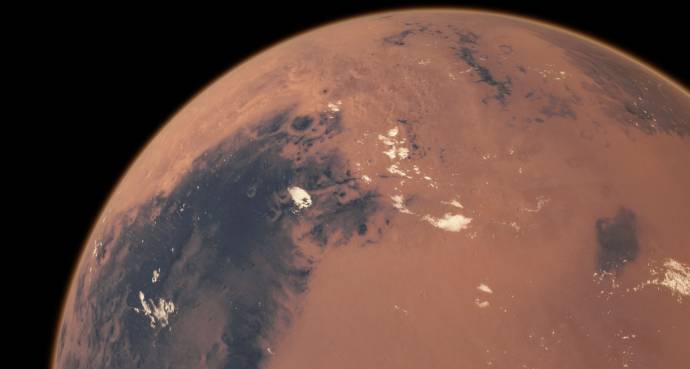
But the only issue is as you mentioned, the color.
Intel Core i7-5820K 4.2GHz 6-Core Processor
G.Skill Ripjaws V Series 32GB (4 x 8GB) DDR4-2400 Memory
EVGA GTX 980 Ti SC 6GB
Edited by DoctorOfSpace - Monday, 27.08.2012, 22:16 |
| |
| |
| HarbingerDawn | Date: Monday, 27.08.2012, 22:24 | Message # 36 |
 Cosmic Curator
Group: Administrators
 United States
United States
Messages: 8717
Status: Offline
| Quote (XMINEIROCREEPEIROGENERALX) Where is the download button?
The download button for what?
Quote (DoctorOfSpace) But the only issue is as you mentioned, the color.
It's not really an obstacle for planets that don't have procedural surfaces, as you can specify whatever color you like for the clouds without affecting the surface (add colorDesert (0.700, 0.700, 0.700, 0.000) in the Surface tag, for example).
The way to get around it on procedural worlds is to make the world a Terra instead of a Desert, and then to make an Ocean height of 0.1 or some such number so that you never really see any water (if you do find a deep enough hole you can always just Ctrl-C to disable it).
I like what you have so far for the Mars clouds!
All forum users, please read this!
My SE mods and addons
Phenom II X6 1090T 3.2 GHz, 16 GB DDR3 RAM, GTX 970 3584 MB VRAM
Edited by HarbingerDawn - Monday, 27.08.2012, 22:37 |
| |
| |
| DoctorOfSpace | Date: Monday, 27.08.2012, 22:35 | Message # 37 |
 Galaxy Architect
Group: Global Moderators
 Pirate
Pirate
Messages: 3600
Status: Offline
| Quote (HarbingerDawn) It's not really an obstacle for planets that don't have procedural surfaces, as you can specify whatever color you like for the clouds without affecting the surface (add colorDesert (0.700, 0.700, 0.700, 0.000) in the Surface tag, for example).
I didn't know that so thanks. That helps me in more ways than one, as I'm experimenting in editing and making planets.
Quote (HarbingerDawn) I like what you have so far for the Mars clouds!
With what you posted and a small tweak
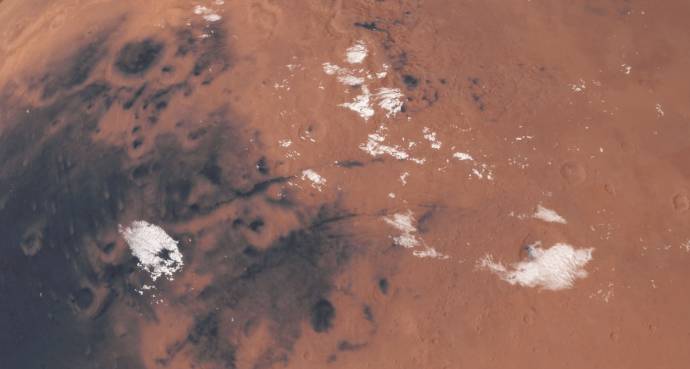
Intel Core i7-5820K 4.2GHz 6-Core Processor
G.Skill Ripjaws V Series 32GB (4 x 8GB) DDR4-2400 Memory
EVGA GTX 980 Ti SC 6GB
|
| |
| |
| HarbingerDawn | Date: Monday, 27.08.2012, 22:42 | Message # 38 |
 Cosmic Curator
Group: Administrators
 United States
United States
Messages: 8717
Status: Offline
| Quote (DoctorOfSpace) With what you posted and a small tweak
Looks nice. The chief problem with creating Mars clouds, and the reason I didn't try it before, is that procedural clouds look really opaque and thick, and Mars's clouds are very thin. But now that there is a texture export feature, once you get the clouds the way you want you can export the texture, decrease the opacity in an image editor, and then run it through CubeMap. Then you've got yourself some mighty fine Mars clouds 
All forum users, please read this!
My SE mods and addons
Phenom II X6 1090T 3.2 GHz, 16 GB DDR3 RAM, GTX 970 3584 MB VRAM
|
| |
| |
| DoctorOfSpace | Date: Monday, 27.08.2012, 22:59 | Message # 39 |
 Galaxy Architect
Group: Global Moderators
 Pirate
Pirate
Messages: 3600
Status: Offline
| Quote (HarbingerDawn) is that procedural clouds look really opaque and thick
I'm not using procedural clouds though. I am using that Earth clouds as a bump only method and adjusting the coverage settings. I tried procedural but it didn't look good at all, even with low twist zones and low coverage.
I wonder if you could help me out though with something I am trying to do to Mars.
I am trying to make a "realistic" Terraformed Mars. I say realistic because I'd like to keep it as a desert world listing but give it some water. However when I launch under the desert flag it looks like this
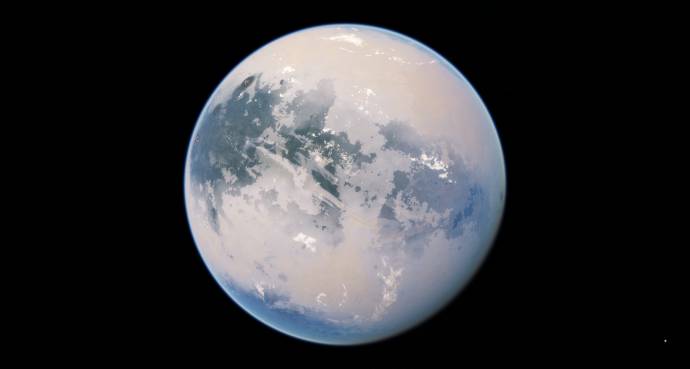
I have to open it in the editor to look like this
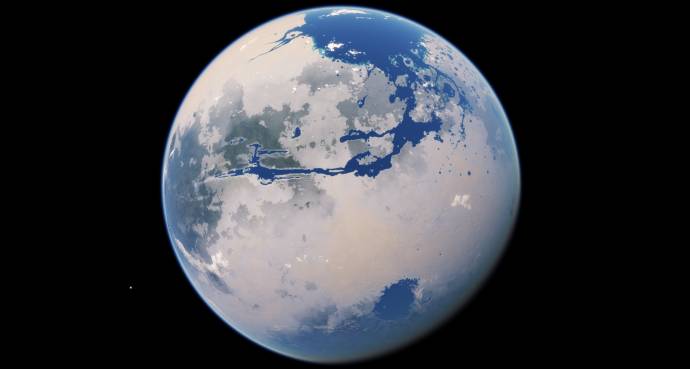
It may be because it should be listed as Terra but I'd like to keep it under the Desert flag and only have the life section centered around the equator with low clouds and lots of water.
Intel Core i7-5820K 4.2GHz 6-Core Processor
G.Skill Ripjaws V Series 32GB (4 x 8GB) DDR4-2400 Memory
EVGA GTX 980 Ti SC 6GB
|
| |
| |
| HarbingerDawn | Date: Monday, 27.08.2012, 23:30 | Message # 40 |
 Cosmic Curator
Group: Administrators
 United States
United States
Messages: 8717
Status: Offline
| Quote (DoctorOfSpace) It may be because it should be listed as Terra but I'd like to keep it under the Desert flag and only have the life section centered around the equator with low clouds and lots of water.
hmmm.... listing it as a Terra may be a necessary sacrifice (and by SE's classification scheme it most certainly would be anyway). Does the water appear as soon as you open the editor, or is there a parameter that you edit with the UI first?
Also, changing it from desert to terra shouldn't affect the texturing, all else being equal (when I switched a desert world I was working on to being a terra, nothing changed save for the ocean). But I'm not sure in this case, and you're in a better position to know than I am.
Quote (DoctorOfSpace) I'm not using procedural clouds though. I am using that Earth clouds as a bump only method and adjusting the coverage settings.
But they are still using a procedural diffuse map, which is what I meant, so they are drawn in the heavy, thick way that procedural clouds are in SE. For a terraformed cloud set it is not a problem, but for a realistic Mars cloud map it will always look slightly awkward, which is why extra work would be needed to get it to look perfect (but how perfect it would be!).
All forum users, please read this!
My SE mods and addons
Phenom II X6 1090T 3.2 GHz, 16 GB DDR3 RAM, GTX 970 3584 MB VRAM
|
| |
| |
| DoctorOfSpace | Date: Monday, 27.08.2012, 23:38 | Message # 41 |
 Galaxy Architect
Group: Global Moderators
 Pirate
Pirate
Messages: 3600
Status: Offline
| Quote (HarbingerDawn) Does the water appear as soon as you open the editor, or is there a parameter that you edit with the UI first?
The water is added in the config but only appears in one small area. When I open the editor the water only expands slightly and not to where I'd like it to be.
Quote (HarbingerDawn) Also, changing it from desert to terra shouldn't affect the texturing
It does actually depending on what parameters are edited. I am working off of the Earth like Mars edit and when I switch to Desert the plant life becomes darker green and the deserts are spread out more where I'd like them to be.
Edit
Terra Mars
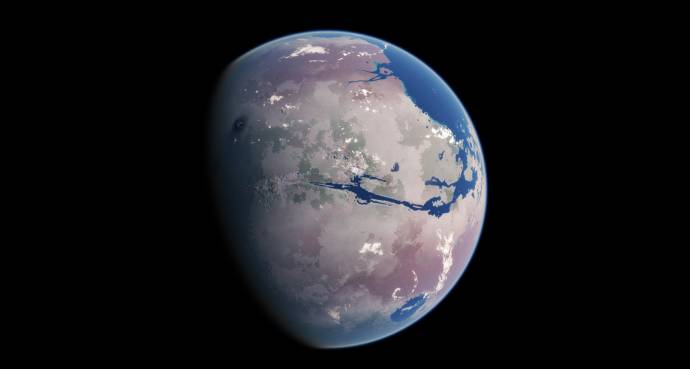
Desert Mars
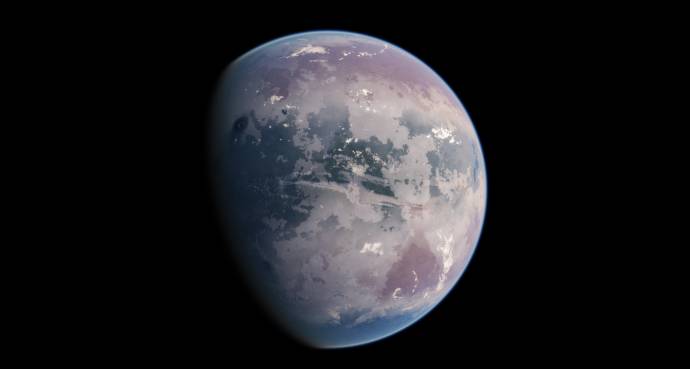
Quote (HarbingerDawn) But they are still using a procedural diffuse map, which is what I meant, so they are drawn in the heavy, thick way that procedural clouds are in SE.
Ah I see what you mean. Yeah I could look into that, in fact I think I will. I'll get back to you on it though.
Quote (HarbingerDawn) For a terraformed cloud set it is not a problem, but for a realistic Mars cloud map it will always look slightly awkward
Mars is undeniably my favorite planet to work with so I'm doing multiple sets of things to it. I have a lot of configs for Mars and one of them is realistic current Mars where I'm tweaking a bunch of things like the clouds.
Quote (HarbingerDawn) which is why extra work would be needed to get it to look perfect (but how perfect it would be!).
That shouldn't be very hard at all really. Not a lot of extra work, all I'd have to do is adjust the color setting in game and then export it and tweak the hue and transparency in an editor.
Intel Core i7-5820K 4.2GHz 6-Core Processor
G.Skill Ripjaws V Series 32GB (4 x 8GB) DDR4-2400 Memory
EVGA GTX 980 Ti SC 6GB
Edited by DoctorOfSpace - Monday, 27.08.2012, 23:54 |
| |
| |
| HarbingerDawn | Date: Tuesday, 28.08.2012, 00:01 | Message # 42 |
 Cosmic Curator
Group: Administrators
 United States
United States
Messages: 8717
Status: Offline
| Quote (DoctorOfSpace) It does actually depending on what parameters are edited. I am working off of the Earth like Mars edit and when I switch to Desert the plant life becomes darker green and the deserts are spread out more where I'd like them to be.
Do you export the script and use that in your catalog file? (Actually of course you did, man am I sleep deprived  ) The problem is probably the discrepancy in sea level between the two worlds. It doesn't make any sense that the colors would change though. ) The problem is probably the discrepancy in sea level between the two worlds. It doesn't make any sense that the colors would change though.
Quote (DoctorOfSpace) all I'd have to do is adjust the color setting in game and then export it and tweak the hue and transparency in an editor.
I have a sneaking feeling that it will be harder than it sounds. My graphics card times out when trying to export large textures and so crashes the program. I would need to edit the registry to overcome that limitation.
You could also create a dust cloud texture and use it as a separate cloud layer to give Mars the two distinct types of clouds that it has in real life (obviously you could not use procedural clouds with this method, but there are other ways that you could if you wanted).
All forum users, please read this!
My SE mods and addons
Phenom II X6 1090T 3.2 GHz, 16 GB DDR3 RAM, GTX 970 3584 MB VRAM
|
| |
| |
| DoctorOfSpace | Date: Tuesday, 28.08.2012, 00:34 | Message # 43 |
 Galaxy Architect
Group: Global Moderators
 Pirate
Pirate
Messages: 3600
Status: Offline
| Quote (HarbingerDawn) Do you export the script and use that in your catalog file?
Yes but I don't put all the entries into the file.
Quote (HarbingerDawn) The problem is probably the discrepancy in sea level between the two worlds.
I have tried making it high but until I put it higher than the clouds, on the desert world, I can't see it besides in lowlands.
Quote (HarbingerDawn) It doesn't make any sense that the colors would change though.
I adjusted the settings on Desert Mars to be more appropriate and then switched back to Terra and this happened
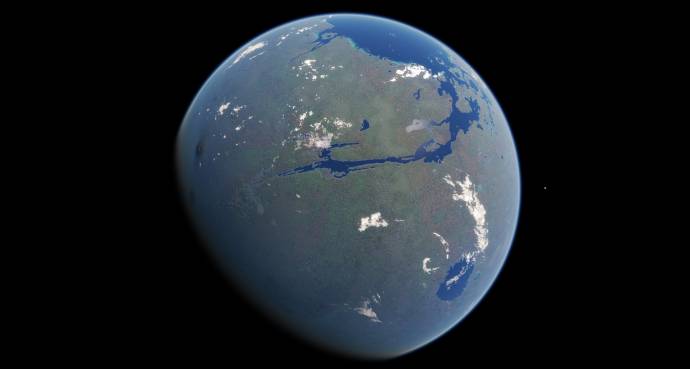
I think there is something I am doing that makes the 2 planet settings very different.
Quote (HarbingerDawn) You could also create a dust cloud texture and use it as a separate cloud layer to give Mars the two distinct types of clouds that it has in real life (obviously you could not use procedural clouds with this method, but there are other ways that you could if you wanted).
I didn't know that but now that I do I'll try it eventually.
That doesn't work with procedural or two separated custom cloud textures. I either end up with a dust layer and low res cloud blotches or an opaque Mars.
Intel Core i7-5820K 4.2GHz 6-Core Processor
G.Skill Ripjaws V Series 32GB (4 x 8GB) DDR4-2400 Memory
EVGA GTX 980 Ti SC 6GB
Edited by DoctorOfSpace - Tuesday, 28.08.2012, 09:53 |
| |
| |
| SpaceEngineer | Date: Tuesday, 28.08.2012, 18:13 | Message # 44 |
 Author of Space Engine
Group: Administrators
 Russian Federation
Russian Federation
Messages: 4800
Status: Offline
| Take a look on the "Style" parameter - it set up the default coloring scheme. There are 3 color schemes for deserts and terras:
0.000 < Style < 0.333 - ligth yellow (sand) color
0.333 < Style < 0.666 - more reddish (Earth) colors
0.666 < Style < 1.000 - red (Mars) colors
Inside these 3 zones, there are 3 subzones that set up the water color:
0.0 < waterStyle < 0.5 - blue water
0.5 < waterStyle < 0.8 - green water
0.8 < waterStyle < 1.0 - red water
Final Style = Style + waterStyle / 3.0, i.e. if you want to have a red planet with green oceans, you should use Style = 0.667 + 0.5 / 3.0 + 0.05 = 0.8833 (the 0.05 added to ensure you cross the subzone boundary).
Colors of the plants are determined taking into account temperature of the star and average temperature on the planet:
star T < 4000K - black plants
4000K < star T < 7000K - green plants
7000K < star T - blue plants
planet T < 260 K - more pink plants
planrt T > 300 K - more yellow plants
If you don't like this colors, you always may use colorLowPlants and colorUpPlants in th script.

|
| |
| |
| Arron17 | Date: Tuesday, 28.08.2012, 18:36 | Message # 45 |
|
Observer
Group: Users
 United Kingdom
United Kingdom
Messages: 18
Status: Offline
| I'm having a problem making planets and I'm not sure what I'm doing wrong, this is the code I have used.
Code Planet "Rock 1" // Type of object ant it's name
{
ParentBody "Hermes" // The body, around wich this planet orbits
Class "Selena" // Class of a planet
Radius 4013.5 // Radius in km
Mass 0.24 // Mass in Earth's masses
Oblateness 0.0 // Oblataness
Albedo 0.07 // Albedo
Color (1.000, 1.000, 0.934 ) // Color of a particle
Surface // Surface tag
{
BumpHeight 25.4 // Max height of landscape in km
BumpOffset 1.3 // Offset of zero height level
DiffMapAlpha "None" // Mode of specular effect (flecks of sunlight)
DayAmbient 0.8 // Brightness of fake daytime ambient light
Lommel 1.0 // Lambert to Lommel-Seeliger lighting model ratio
Exposure 2.0 // Global surface brighness
Life false // true, if there is life on the planet
// Next are parameters for procedural surface generation
Style 0.589168 // Default color scheme
Randomize (-0.031, -0.725, -0.872) // Randomize vector
colorDistMagn 0.04671758 // Magnitude of detail textures distortion
colorDistFreq 14.59185 // Frequency of detail textures distortion
detailScale 665.3179 // Scale of detail textures
colorConversion true // Perform textures color conversion
seaLevel 0.2344274 // Mare level height (0...1)
snowLevel 0.990009 // Snow line level (0...1)
tropicLatitude 0.0 // Latitude of tropics
icecapLatitude 0.5 // Latitude of ice caps boundaries
icecapHeight 0.4566726 // Height of ice caps
climatePole 1.000 // Climate of poles - index to color table (0...1)
climateTropic 0.450 // Climate of tropics - index to color table (0...1)
climateEquator 0.625 // Climate of equator - index to color table (0...1)
tropicWidth 0.07 // Width of tropics
mainFreq 1.770453 // Main noise frequency (oceans/continents)
venusFreq 0.90631 // Venus-like global structures frequency
venusMagn 0.1794956 // Venus-like global structures magnitude
mareFreq 1.590966 // Lunar mare frequency
mareDensity 0.1880112 // Lunar mare density
montesMagn 0.2106156 // Lunar mare magnitude
montesFreq 447.9364 // Lunar mare frequency
montesDensity 0.1032389 // Lunar mare density
dunesMagn 0.05065665 // Dunes magnitude (0...1)
dunesFreq 7542.516 // Dunes frequency
dunesDensity 0.0 // Dunes density
hillsMagn 0.125375 // Hills magnitude (0...1)
hillsFreq 0.3447827 // Hills frequency
hillsDensity 0.5050473 // Hills density
canyonMagn 0.003447684 // Canyons magnitude (0...1)
canyonFreq 658.1566 // Canyons frequency
canyonDensity 0.3917769 // Canyons density
cracksMagn 0.02371026 // Ice cracks magnitude (0...1)
cracksFreq 2.237627 // Ice cracks frequency
cracksOctaves 0 // Number of ice cracks octaves
craterMagn 0.6555124 // Craters magnitude
craterFreq 17.41361 // Craters frequency
craterDensity 0.8474388 // Craters density
craterOctaves 10 // Number of craters octaves
craterRayedFactor 0.2032161 // Number of rayed craters relative to usual craters
colorSea (0.400, 0.350, 0.320, 0.000) // Color of mare
colorShelf (0.470, 0.410, 0.380, 0.000) // Color of mare
colorBeach (0.560, 0.470, 0.420, 0.000) // Color of continents
colorDesert (0.510, 0.440, 0.370, 0.200) // Color of continents
colorLowland (0.390, 0.340, 0.280, 0.500) // Color of continents
colorUpland (0.660, 0.600, 0.520, 0.800) // Color of continents
colorRock (0.670, 0.620, 0.550, 1.000) // Color of continents
colorSnow (1.000, 1.000, 1.000, 1.000) // Color of continents
}
Orbit // Orbit tag
{
RefPlane "Ecliptic" // Orbit reference plane
Epoch 2451545.0 // Orbital parameters epoch, Julian date
Period 0.227794 // Orbital period in years
Eccentricity 0.021 // Eccentricity
Inclination 0.000052 // Inclination in degrees
AscendingNode -78.3 // Longitude of ascending node in degrees
// Next two are interchangeable: SemiMajorAxis = PericenterDist / (1.0 - Eccentricity)
SemiMajorAxis 0.399737964 // Semimajor axis in astronomical units
//PericenterDist 0.378737964 // Pericentric distanse in astronomical units
// Next two are interchangeable: ArgOfPericen = LongOfPericen - AscendingNode
ArgOfPericen 297 // (or ArgOfPericenter) Argument of pericenter in degrees
//LongOfPericen 308.09011 // (or LongOfPericenter) Longitude of pericenter in degrees
// Next two are interchangeable: MeanAnomaly = MeanLongitude - LongOfPericen
MeanAnomaly 88.5 // Mean anomaly in degrees
//MeanLongitude 296.93974 // Mean longitude in degrees
//AscNodePreces 131795.3 // Ascending node precession period in years
//ArgOfPeriPreces 26799.51 // Argument of pericenter precession period in years
}
}
The planet is the right type and has the correct orbit but for some reason every planet I add has an atmosphere even though I haven't specified one. What am I doing wrong?
Intel Core i3-330m, 4GB RAM, ATi Radeon 5650 1GB
|
| |
| |